Patrick Gebhard
AutoPsyC: Automatic Recognition of Psychodynamic Conflicts from Semi-structured Interviews with Large Language Models
Mar 27, 2025Abstract:Psychodynamic conflicts are persistent, often unconscious themes that shape a person's behaviour and experiences. Accurate diagnosis of psychodynamic conflicts is crucial for effective patient treatment and is commonly done via long, manually scored semi-structured interviews. Existing automated solutions for psychiatric diagnosis tend to focus on the recognition of broad disorder categories such as depression, and it is unclear to what extent psychodynamic conflicts which even the patient themselves may not have conscious access to could be automatically recognised from conversation. In this paper, we propose AutoPsyC, the first method for recognising the presence and significance of psychodynamic conflicts from full-length Operationalized Psychodynamic Diagnostics (OPD) interviews using Large Language Models (LLMs). Our approach combines recent advances in parameter-efficient fine-tuning and Retrieval-Augmented Generation (RAG) with a summarisation strategy to effectively process entire 90 minute long conversations. In evaluations on a dataset of 141 diagnostic interviews we show that AutoPsyC consistently outperforms all baselines and ablation conditions on the recognition of four highly relevant psychodynamic conflicts.
Avatar Visual Similarity for Social HCI: Increasing Self-Awareness
Aug 23, 2024



Abstract:Self-awareness is a critical factor in social human-human interaction and, hence, in social HCI interaction. Increasing self-awareness through mirrors or video recordings is common in face-to-face trainings, since it influences antecedents of self-awareness like explicit identification and implicit affective identification (affinity). However, increasing self-awareness has been scarcely examined in virtual trainings with virtual avatars, which allow for adjusting the similarity, e.g. to avoid negative effects of self-consciousness. Automatic visual similarity in avatars is an open issue related to high costs. It is important to understand which features need to be manipulated and which degree of similarity is necessary for self-awareness to leverage the added value of using avatars for self-awareness. This article examines the relationship between avatar visual similarity and increasing self-awareness in virtual training environments. We define visual similarity based on perceptually important facial features for human-human identification and develop a theory-based methodology to systematically manipulate visual similarity of virtual avatars and support self-awareness. Three personalized versions of virtual avatars with varying degrees of visual similarity to participants were created (weak, medium and strong facial features manipulation). In a within-subject study (N=33), we tested effects of degree of similarity on perceived similarity, explicit identification and implicit affective identification (affinity). Results show significant differences between the weak similarity manipulation, and both the strong manipulation and the random avatar for all three antecedents of self-awareness. An increasing degree of avatar visual similarity influences antecedents of self-awareness in virtual environments.
Recognizing Emotion Regulation Strategies from Human Behavior with Large Language Models
Aug 08, 2024Abstract:Human emotions are often not expressed directly, but regulated according to internal processes and social display rules. For affective computing systems, an understanding of how users regulate their emotions can be highly useful, for example to provide feedback in job interview training, or in psychotherapeutic scenarios. However, at present no method to automatically classify different emotion regulation strategies in a cross-user scenario exists. At the same time, recent studies showed that instruction-tuned Large Language Models (LLMs) can reach impressive performance across a variety of affect recognition tasks such as categorical emotion recognition or sentiment analysis. While these results are promising, it remains unclear to what extent the representational power of LLMs can be utilized in the more subtle task of classifying users' internal emotion regulation strategy. To close this gap, we make use of the recently introduced \textsc{Deep} corpus for modeling the social display of the emotion shame, where each point in time is annotated with one of seven different emotion regulation classes. We fine-tune Llama2-7B as well as the recently introduced Gemma model using Low-rank Optimization on prompts generated from different sources of information on the \textsc{Deep} corpus. These include verbal and nonverbal behavior, person factors, as well as the results of an in-depth interview after the interaction. Our results show, that a fine-tuned Llama2-7B LLM is able to classify the utilized emotion regulation strategy with high accuracy (0.84) without needing access to data from post-interaction interviews. This represents a significant improvement over previous approaches based on Bayesian Networks and highlights the importance of modeling verbal behavior in emotion regulation.
Socially Interactive Agents for Robotic Neurorehabilitation Training: Conceptualization and Proof-of-concept Study
Jun 17, 2024Abstract:Individuals with diverse motor abilities often benefit from intensive and specialized rehabilitation therapies aimed at enhancing their functional recovery. Nevertheless, the challenge lies in the restricted availability of neurorehabilitation professionals, hindering the effective delivery of the necessary level of care. Robotic devices hold great potential in reducing the dependence on medical personnel during therapy but, at the same time, they generally lack the crucial human interaction and motivation that traditional in-person sessions provide. To bridge this gap, we introduce an AI-based system aimed at delivering personalized, out-of-hospital assistance during neurorehabilitation training. This system includes a rehabilitation training device, affective signal classification models, training exercises, and a socially interactive agent as the user interface. With the assistance of a professional, the envisioned system is designed to be tailored to accommodate the unique rehabilitation requirements of an individual patient. Conceptually, after a preliminary setup and instruction phase, the patient is equipped to continue their rehabilitation regimen autonomously in the comfort of their home, facilitated by a socially interactive agent functioning as a virtual coaching assistant. Our approach involves the integration of an interactive socially-aware virtual agent into a neurorehabilitation robotic framework, with the primary objective of recreating the social aspects inherent to in-person rehabilitation sessions. We also conducted a feasibility study to test the framework with healthy patients. The results of our preliminary investigation indicate that participants demonstrated a propensity to adapt to the system. Notably, the presence of the interactive agent during the proposed exercises did not act as a source of distraction; instead, it positively impacted users' engagement.
Fine-grained Affective Processing Capabilities Emerging from Large Language Models
Sep 04, 2023Abstract:Large language models, in particular generative pre-trained transformers (GPTs), show impressive results on a wide variety of language-related tasks. In this paper, we explore ChatGPT's zero-shot ability to perform affective computing tasks using prompting alone. We show that ChatGPT a) performs meaningful sentiment analysis in the Valence, Arousal and Dominance dimensions, b) has meaningful emotion representations in terms of emotion categories and these affective dimensions, and c) can perform basic appraisal-based emotion elicitation of situations based on a prompt-based computational implementation of the OCC appraisal model. These findings are highly relevant: First, they show that the ability to solve complex affect processing tasks emerges from language-based token prediction trained on extensive data sets. Second, they show the potential of large language models for simulating, processing and analyzing human emotions, which has important implications for various applications such as sentiment analysis, socially interactive agents, and social robotics.
Towards social embodied cobots: The integration of an industrial cobot with a social virtual agent
Jan 16, 2023Abstract:The integration of the physical capabilities of an industrial collaborative robot with a social virtual character may represent a viable solution to enhance the workers' perception of the system as an embodied social entity and increase social engagement and well-being at the workplace. An online study was setup using prerecorded video interactions in order to pilot potential advantages of different embodied configurations of the cobot-avatar system in terms of perceptions of Social Presence, cobot-avatar Unity and Social Role of the system, and explore the relation of these. In particular, two different configurations were explored and compared: the virtual character was displayed either on a tablet strapped onto the base of the cobot or on a large TV screen positioned at the back of the workcell. The results imply that participants showed no clear preference based on the constructs, and both configurations fulfill these basic criteria. In terms of the relations between the constructs, there were strong correlations between perception of Social Presence, Unity and Social Role (Collegiality). This gives a valuable insight into the role of these constructs in the perception of cobots as embodied social entities, and towards building cobots that support well-being at the workplace.
"GAN I hire you?" -- A System for Personalized Virtual Job Interview Training
Jun 08, 2022
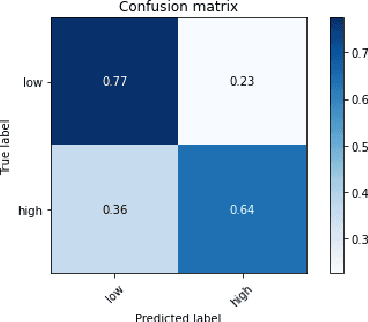
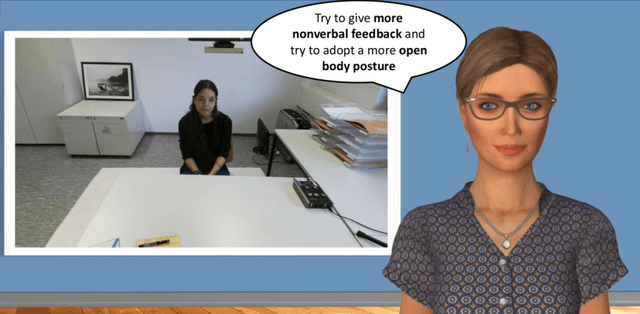
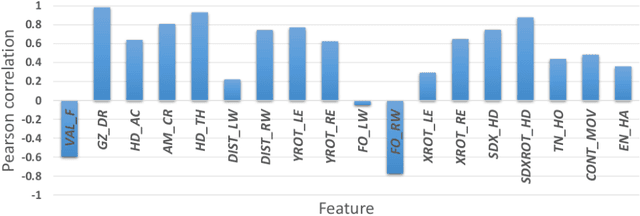
Abstract:Job interviews are usually high-stakes social situations where professional and behavioral skills are required for a satisfactory outcome. Professional job interview trainers give educative feedback about the shown behavior according to common standards. This feedback can be helpful concerning the improvement of behavioral skills needed for job interviews. A technological approach for generating such feedback might be a playful and low-key starting point for job interview training. Therefore, we extended an interactive virtual job interview training system with a Generative Adversarial Network (GAN)-based approach that first detects behavioral weaknesses and subsequently generates personalized feedback. To evaluate the usefulness of the generated feedback, we conducted a mixed-methods pilot study using mock-ups from the job interview training system. The overall study results indicate that the GAN-based generated behavioral feedback is helpful. Moreover, participants assessed that the feedback would improve their job interview performance.
Employing Socially Interactive Agents for Robotic Neurorehabilitation Training
Jun 03, 2022
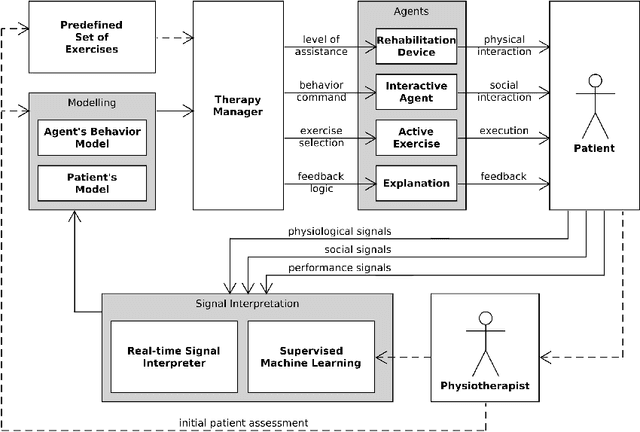
Abstract:In today's world, many patients with cognitive impairments and motor dysfunction seek the attention of experts to perform specific conventional therapies to improve their situation. However, due to a lack of neurorehabilitation professionals, patients suffer from severe effects that worsen their condition. In this paper, we present a technological approach for a novel robotic neurorehabilitation training system. It relies on a combination of a rehabilitation device, signal classification methods, supervised machine learning models for training adaptation, training exercises, and socially interactive agents as a user interface. Together with a professional, the system can be trained towards the patient's specific needs. Furthermore, after a training phase, patients are enabled to train independently at home without the assistance of a physical therapist with a socially interactive agent in the role of a coaching assistant.
Designing a Mobile Social and Vocational Reintegration Assistant for Burn-out Outpatient Treatment
Dec 15, 2020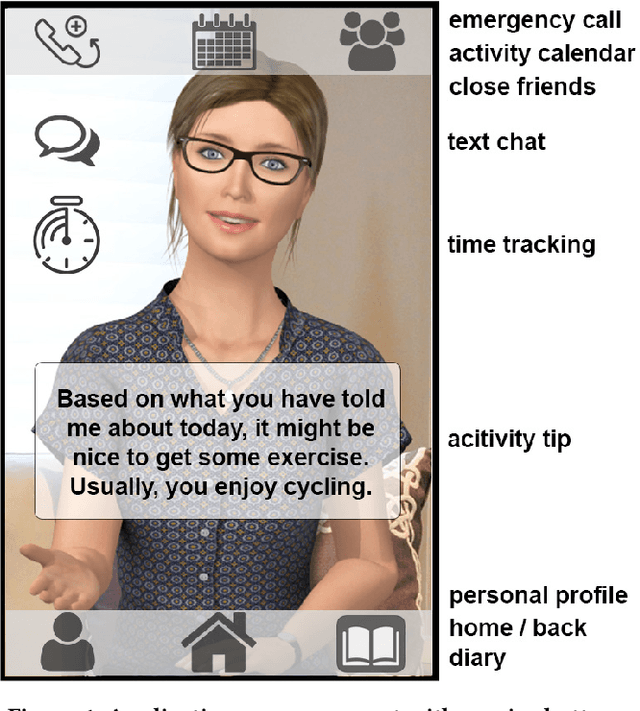
Abstract:Using Social Agents as health-care assistants or trainers is one focus area of IVA research. While their use as physical health-care agents is well established, their employment in the field of psychotherapeutic care comes with daunting challenges. This paper presents our mobile Social Agent EmmA in the role of a vocational reintegration assistant for burn-out outpatient treatment. We follow a typical participatory design approach including experts and patients in order to address requirements from both sides. Since the success of such treatments is related to a patients emotion regulation capabilities, we employ a real-time social signal interpretation together with a computational simulation of emotion regulation that influences the agent's social behavior as well as the situational selection of verbal treatment strategies. Overall, our interdisciplinary approach enables a novel integrative concept for Social Agents as assistants for burn-out patients.
 Add to Chrome
Add to Chrome Add to Firefox
Add to Firefox Add to Edge
Add to Edge